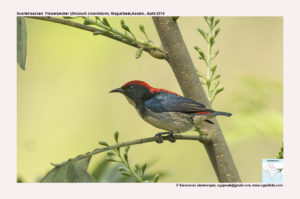Scarlet-backed Flowerpecker

Scarlet- Backed Flowerpecker Dicaeum cruentatum
Etymology:
- Dicaeum: Greek word dikaion supposedly an Indian bird
- Cruentatum:Blood stained from latin word cruor – blood
Vernacular Names: Cachar: Daomoji gajao
Distribution in India: Resident in East Himalayan foothills of India.
Description: Size of 7–9 cm; wt. of male 5·5–8 g, female 6 g. The male of nominate race has deep red on crown to back and rump, side of head is black, upperwing and tail are glossy blue-black; sides of throat and upper breast is black, flanks are grey, center of throat, breast and belly are pale buff, white pectoral tufts. The iris is brown; bill and legs are black or blackish-green. The female is olive-brown to grey-brown above with orange tinge on back, except for scarlet on uppertail-coverts, black tail, dark brown wing; throat is greyish-white, rest of buff underparts are pale buff to whitish, sometimes with slight olive wash, sides and flanks are greyer, narrow white central stripe. The juvenile is similar to female, but more buffish below, lacks red on rump and has orange bill with paler base
Habitat: It is found in Woodland, cultivation, mangroves, open areas and gardens. It is found from sea-level to 2100 m.
Food Habits: It eats fruits and nectar, particularly of mistletoes and figs, spiders and insects. It forages generally in canopy. It forages singly and in pairs; outside breeding season sometimes in small groups and in mixed-species flocks. It hawks flying insects by sallying from perch and hovering.
Breeding Habits: They breed in Mar-Aug in India. The nest is a globular mass with large entrance hole stretching from top to middle point of side, made from fine twigs and plant fibers, lined with plant down. It lays a clutch of 2-4 eggs.The incubation is done by both sexes for a period of 10–11 days. Both parents also provision nestlings and tend fledglings.